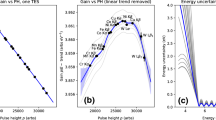Abstract
Design of TES microcalorimeters requires a tradeoff between resolution and dynamic range. Often, experimenters will require linearity for the highest energy signals, which requires additional heat capacity be added to the detector. This results in a reduction of low energy resolution in the detector. We derive and demonstrate an algorithm that allows operation far into the nonlinear regime with little loss in spectral resolution. We use a least squares optimal filter that varies with photon energy to accommodate the nonlinearity of the detector and the non-stationarity of the noise. The fitting process we use can be seen as an application of differential geometry. This recognition provides a set of well-developed tools to extend our work to more complex situations. The proper calibration of a nonlinear microcalorimeter requires a source with densely spaced narrow lines. A pulsed laser multi-photon source is used here, and is seen to be a powerful tool for allowing us to develop practical systems with significant detector nonlinearity. The combination of our analysis techniques and the multi-photon laser source create a powerful tool for increasing the performance of future TES microcalorimeters.











Similar content being viewed by others
References
D.J. Fixsen, S.H. Moseley, B. Cabrera, E. Figueroa-Feliciano, Pulse estimation in nonlinear detectors with nonstationary noise. Nucl. Instr Methods Phys. Res. A 520, 555–558 (2004)
A.E. Lita, A.J. Miller, S.W. Nam, Counting near-infrared single-photons with 95 % efficiency. Opt. Express 16, 3032 (2008)
T. Gerrits, B. Calkins, N. Tomlin, A.E. Lita, A. Migdall, R. Mirin, S.W. Nam, Extending single-photon optimized superconducting transition edge sensors beyond the single-photon counting regime. Opt. Express 20, 23798 (2012)
D. Rosenberg, A.E. Lita, A.J. Miller, S.W. Nam, Noise-free high-efficiency photon-number-resolving detectors. Phys. Rev. A 71, 061803 (2005)
A.J. Miller, A.E. Lita, B. Calkins, I. Vayshenker, S.M. Gruber, S.W. Nam, Compact cryogenic self-aligning fiber-to-detector coupling with losses below one percent. Opt. Express 19, 9102–9110 (2011)
P.A.M. Dirac, General Theory of Relativity (Princeton University Press, Princeton, 1996)
C. Misner, K. Thorne, J. Wheeler, in Gravitation, vol. 3, ed. by W. H. Freeman (1973)
Acknowledgments
We would like to thank Sarah Busch, Simon Bandler, and Steve Smith for helpful discussions about nonlinear detector response, and Dan McCammon for a wide range of helpful discussions.
Author information
Authors and Affiliations
Corresponding author
Additional information
Contribution of NIST, an agency of the U.S. Government, not subject to copyright.
Rights and permissions
About this article
Cite this article
Fixsen, D.J., Moseley, S.H., Gerrits, T. et al. Optimal Energy Measurement in Nonlinear Systems: An Application of Differential Geometry. J Low Temp Phys 176, 16–26 (2014). https://doi.org/10.1007/s10909-014-1149-x
Received:
Accepted:
Published:
Issue Date:
DOI: https://doi.org/10.1007/s10909-014-1149-x




